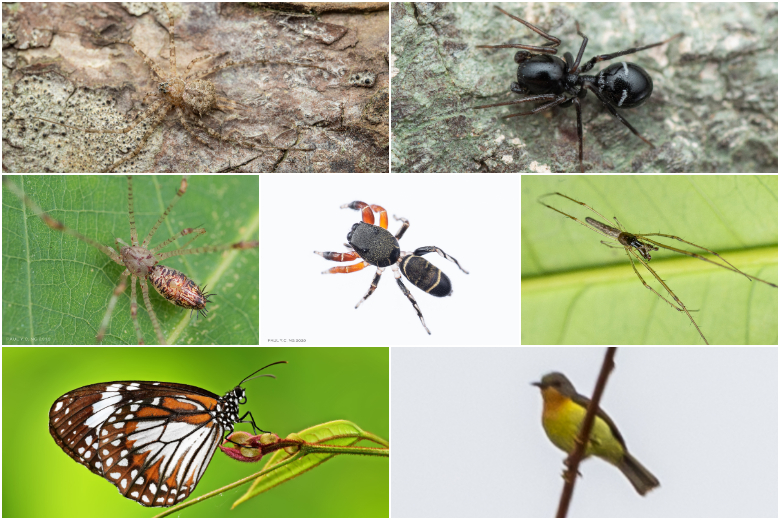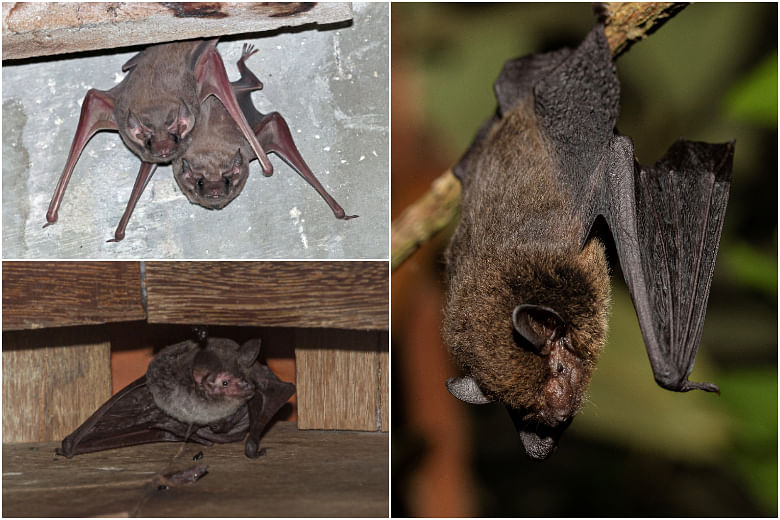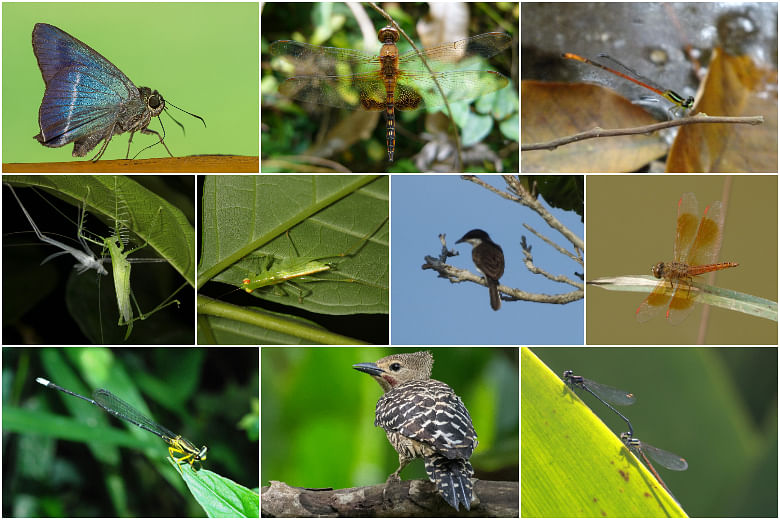20 new animal species recorded on Ubin, including spider species new to science: NParks
Sign up now: Get ST's newsletters delivered to your inbox

Piranthus sp. (centre), a spider species new to science, and six other animal species recorded in Singapore for the first time.
PHOTOS: CHRIS ANG, KHEW SIN KHOON, PAUL NG, ROGER BOEY
Follow topic:
SINGAPORE - Twenty new animal species have so far been recorded on Pulau Ubin, as part of the first comprehensive survey of biodiversity on the rustic island north-east of the mainland.
The discoveries include Piranthus sp., a spider species new to science, found in the secondary forest near the island's coast.
Researchers combing the island during the survey also found six other animal species recorded in Singapore for the first time, as well as 13 other animals never before known to be found on Pulau Ubin.
The findings of the first Comprehensive Ubin Biodiversity Survey (Cubs) were announced by National Development Minister Desmond Lee on Friday (Sept 25), ahead of the ninth Ubin Day on Saturday.
The event has been held since 2002 to celebrate the rich natural and cultural heritage of the quarry-dotted island. Due to the Covid-19 situation this year, a series of talks on a range of Ubin-related issues, such as the history of the island and its rich mangrove habitats, will be conducted online.
"The unique biodiversity found on Pulau Ubin is fascinating," said Mr Lee in a Facebook post.
"Let us continue to preserve and treasure the rustic charm and natural beauty of Pulau Ubin," he added.
Findings from the survey will enable the National Parks Board (NParks) to update Pulau Ubin's biodiversity baseline data and its species inventory.
Piranthus sp., for example, has been seen in other parts of Singapore and in Brunei before. But those were wrongly classified as belonging to a different genus.
It was not until the spider was found on Pulau Ubin during the survey and closely examined by researchers that it was determined to be a completely new species yet to be described in scientific literature.
Other new animal species found in Singapore for the first time during the survey include the ruby-cheeked sunbird, so called for the blush on the face of adult males, the swamp tiger butterfly and four other species of spiders.
Mr Khew Sin Khoon, who runs the Butterfly Circle (Singapore) citizen science blog documenting Singapore's butterflies, told The Straits Times that the swamp tiger butterfly, in a serendipitous discovery, was found on Butterfly Hill on Ubin.
"The swamp tiger is pretty rare even in Malaysia, and found mainly in mangrove habitats like at Kuala Selangor. My theory is that it also exists in the mangrove areas of Johor, and was somehow able to fly over to Ubin," he said.
As the offshore island is a convenient "pit stop" between West Malaysia and Singapore, researchers occasionally find species that stray onto Ubin, New records for the tiny island include three species of bats - the black-bearded tomb bat, Horsfield's large-footed bat, and Javan pipistrelle -and birds such as the buff-rumped woodpecker, as well as species of butterflies, dragonflies and damselflies, and grasshoppers, crickets and katydids.

The Comprehensive Ubin Biodiversity Survey - which involves field surveys conducted by scientists and naturalists across the island for various animal groups - started in January 2018 and is still ongoing.
Since then, field surveys for certain groups of animals - including reptiles, amphibians, birds, butterflies, spiders, and orthopterans, which include grasshoppers, crickets and katydids - have been completed. Surveys are ongoing for other animal groups, including phasmids (leaf and stick insects), mammals and moths and are targeted for completion at the end of this year.

Over 200 NParks staff, researchers from the National University of Singapore and citizen scientists from nature groups such as the Nature Society (Singapore), Herpetological Society of Singapore and Butterfly Circle have taken part in more than 165 field surveys that make up Cubs.
Said Mr Khew: "The ongoing biodiversity surveys by NParks is a good platform for connecting experts and citizen scientists to collaborate on field research. The surveys are important to increase our knowledge of our local habitats and to be able to discover and learn more about our flora and fauna."
On Friday, Mr Lee also announced plans to make the rustic island greener.
As part of the One Million Trees movement - an initiative announced earlier this year which would see a million trees being planted across Singapore over the next decade - 16,000 trees from over 70 native species will be planted at three sites on Ubin.
Currently, the sites, totalling an area of 16ha, are covered with invasive plant species and do not support a high diversity of wildlife.
Removing the invasive species and replanting the areas with native trees will provide additional habitats for the local biodiversity on Ubin - such as the greater mousedeer, Sumatran palm civet, leopard cat, Sunda pangolin and various species of birds, bats and butterflies - to thrive, said NParks.
These wildlife species have been observed using reforested sites as new habitats for roosting and foraging.

